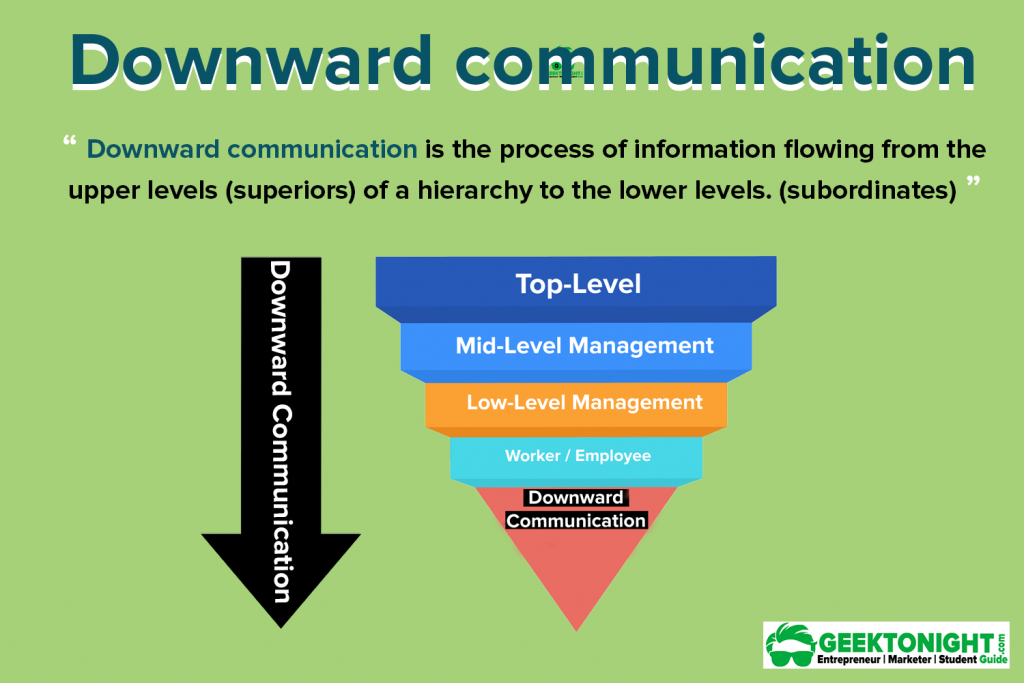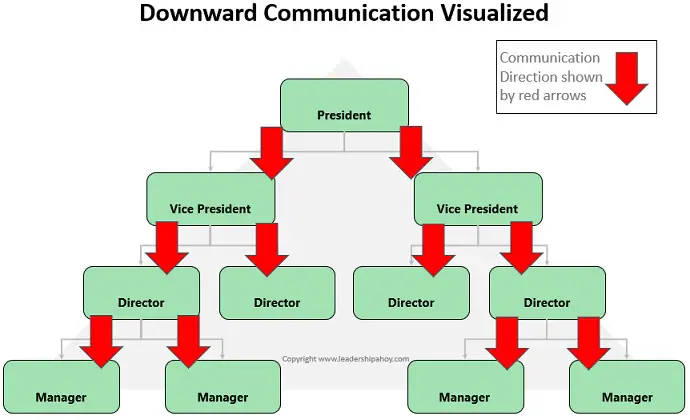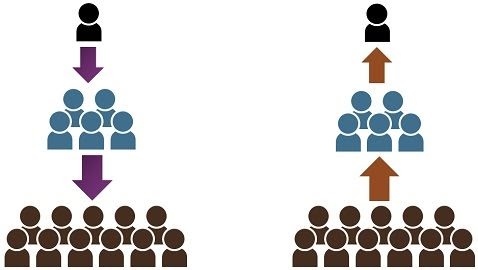
Downward Communication: Is a Top-Down Approach the Best Option?
Last update: 12 June 2023 at 04:15 pm
Establishing efficient workplace communication systems may aid in the delivery of messages to employees and the creation of a well-informed and productive work environment.
When substantial policy changes or vital information has to reach employees at all levels of the firm, businesses can use systems like downward communication to help them communicate more efficiently.
In this piece, we’ll get a complete understanding of downward communication, look at its benefits and drawbacks, and much more.
What Is Downward Communication in Terms of Organizational Hierarchy?
Downward communication refers to communications and information that flow vertically down the chain of command from managers to the people who report to them.
In other words, downward communication occurs when people at higher levels of an organization communicate with those at lower ones. It is, without a doubt, the most well-known and evident method of formal communication.
Downward communication goes from the top of the organization to the bottom of the organization in bigger companies, especially with the directive and authoritarian leaders.

Orders, instructions, directions, information, requests, regulations, and a variety of other items are examples of information. Normally, this is accomplished through the organizational hierarchy or chain of command, but in today’s digital age, it is not uncommon for downward communication to bypass one or more tiers of the hierarchy.
Of course, how we communicate depends on the sort of information we’re talking about.
Vertical Communication Structure
Depending on the nature of information, vertical communication might be either downward or upward. To maintain track of the information, this style of communication is generally written—emails, reports, or notes. However, because it is a more direct way of delivering thoughts or information, spoken vertical communication is equally important. There are two vertical communication types:
Downward Communication
Downward communication occurs when information goes from top management to associates. The management normally sends an email or notifies the next person in charge in this situation. The knowledge may be vital, which is why it’s not shared with staff directly.
Upward Communication
It’s called upward communication when information goes from colleagues to senior management. When workers must update their supervisors on their job status, discuss discoveries or research, or advise them of anything significant, now is the time to do it.
Mechanism of Such Communication
Downward communication can be sent in various methods, especially nowadays. It might be in the form of verbal communication, written forms like e-mails, PowerPoint presentations, movies, or other mediums.
As the business expands, it will become increasingly difficult for the top leader to interact with the whole organization in a timely, effective, and regular manner. Consider a corporation with 200 employees spread over three locations; the CEO or vice president cannot and should not be expected to communicate with every one of them individually. In most cases, the organizational structure is employed instead.
Consider how this 200-person corporation is organized into four departments: sales, warehousing, purchasing, and administration. The CEO might use typical downward communication to tell the leaders of these departments to send a message to everyone in the firm.
These department heads would then pass this information on to their direct reporting mid-level managers, who would ultimately pass it on to the employees at the bottom of the organizational ladder. That is all there is to it.

It is also crucial that employees at all levels of a company understand that tone of voice in communication is just as important as the who and how.
Downward Communication vs Upward Communication
The information flowing process in upward communication begins at the lowest level of a hierarchy and concludes at the top-level management, as the name implies. In a firm, for example, it will begin with an employee.

The process through which information and messages travel from managers and leaders to followers and employees is known as communication downhill. In a team, for example, communication will begin with the leader.
What Is the Point of Employing Downward Communications?
There are five general reasons why a company should employ downward communication:
1.Identifying the best methods for putting goals, plans, and objectives into action.
It assists the company in conveying the mission, organization practices, vision, messages, and objectives established by top-level management to lower-level personnel via internal communication channels in an organizational setting.
2. Disseminating task instructions and justifications.
It aids in the process of disseminating instructions on how to do a task or synchronizing individual and departmental goals.
3. Procedures and practices must be communicated.
Different policies, laws, rules, perks, guidelines, structural arrangements, and so on are used by businesses and organizations, and they are shared utilizing communication from the top to the bottom. It guarantees that the organization’s processes are consistent.
4. Disseminating progress reports and feedback.
This kind of communication is used by organizations and businesses to share departmental progress updates as well as individual performance comments and evaluations. Managers provide employees with feedback on how well they are meeting their performance objectives and standards.
5. Strengthening socialization.
Organizations adopt motivational tactics and utilize downward communication to share such ideas. Staff employees are informed about the organization’s mission and cultural values. They are also invited to take part in unique rituals and activities that assist everyone in mingles and acquainting themselves by giving them a sense of belonging and a common goal.
Media for Downward Communication
Downward communication can take the form of both spoken and written communication.
Important directives to initiate actions may be communicated via letters; policies and procedures may be announced via circulars, house organs, manuals, bulletins, and other means; annual reports may be found useful for informing lower-level employees about the organization’s activities and accomplishments during the year, and posters may be used to communicate miscellaneous information.

Oral communication, on the other hand, dominates the downward flow of information. It is more natural for the boss to give his workers oral directions.
Rather than drafting long letters to the department heads, the Managing Director would organize a meeting of the department heads and pass on essential information to them (in certain cases, letters may, of course, be preferred).
The Managing Director may use a public address system to address all of the staff. For downward communication, audio-visual material like films and slides can be employed. At all time, said managing director can look for the help of an outside qualified public relations agency that can help them with their internal communication.
Advantages of Downward Communication
Below mentioned are some of the advantages of downward communication.
- Because information and orders originate from the sources of authority, downward transmission ensures efficacy and coherence. It allows for the coordination of tasks from higher levels of the business, ensuring staff efficiency.
- A delegation from superiors to workers representing a chain of command becomes much easier and more effective.
- Control, discipline, and member compliance at multiple levels become considerably easier to maintain when downward communication follows the organization’s structure.
- Good ties between the hierarchy are built through downward communication. This communication creates a strong sense of engagement among the subordinates.
Disadvantages of Downward Communication
Some downsides of downward communication are listed below.
- There is a risk of skewed information and messages when information passes through different levels of the business.
- In this style of communication, the risk of losing information is quite real.
- Because information must be moved from one level of employees to another, feedback can be sluggish, resulting in a waste of time.
- Downward communication may have a negative influence in some situations, such as when bosses abuse their position and authority, reducing staff morale.
Effective Downward Communication
Here’s a checklist to help you utilize downward communication effectively:
Make Sure You Fully Comprehend the Content
Whether you’re making the adjustments or conveying information from executives and the board of directors, it’s critical that you thoroughly comprehend the material before passing it on to workers. If the executives are the ones making the decisions, it’s a good idea to ask any clarifying questions you believe employees might have.
It’s also a good idea to write down what you’re going to say or communicate to employees and have other managers or executives go through it to make sure nothing is left out or ignored.
Recognize the Most Effective Mode of Communication
Different sorts of news or instructions may necessitate different communication strategies. Examining the information’s complexity can help determine which method of communication is appropriate.
It might be beneficial to publish a written document or include the information in an updated employee handbook if the firm or organization is implementing significant in-depth policy changes.
If you need to assign essential work or increase an employee’s responsibilities, it may be simpler to communicate with them via written communication, such as an email, or face-to-face discussion. This gives kids the opportunity to ask questions, which may assist clarify instructions and fostering open communication.
Be Truthful
Being open about the difficulty or complexity of corporate adjustments or directions may foster a sense of camaraderie among employees and a commitment to the firm’s growth. It’s a good idea to outline the biggest hurdles or problems with the news, how workers may strive to overcome them, and how you can assist with the transition while employing downward communication.
If two departments are merging and employees are being given new responsibilities, for example, it’s a good idea to mention how you recognize the situation is difficult, but also how individual objectives are being changed until the transition is complete, and how you’re making yourself available for questions and feedback.
Conclusion
Downward communication is important for providing information, assigning tasks, explaining policies/plans, and managing subordinates in an organization.
It may also be used to assign interdepartmental responsibilities, explain how the environment is evolving, share performance evaluations, delegate power, and enforce discipline.






